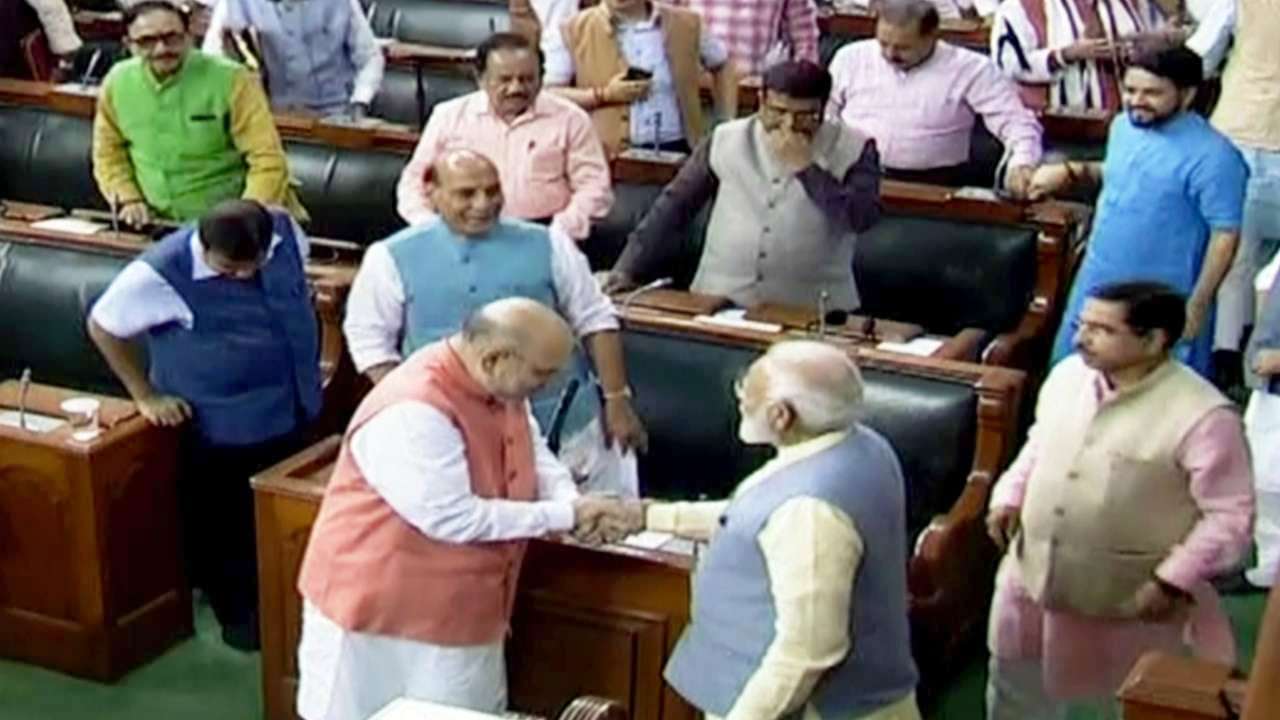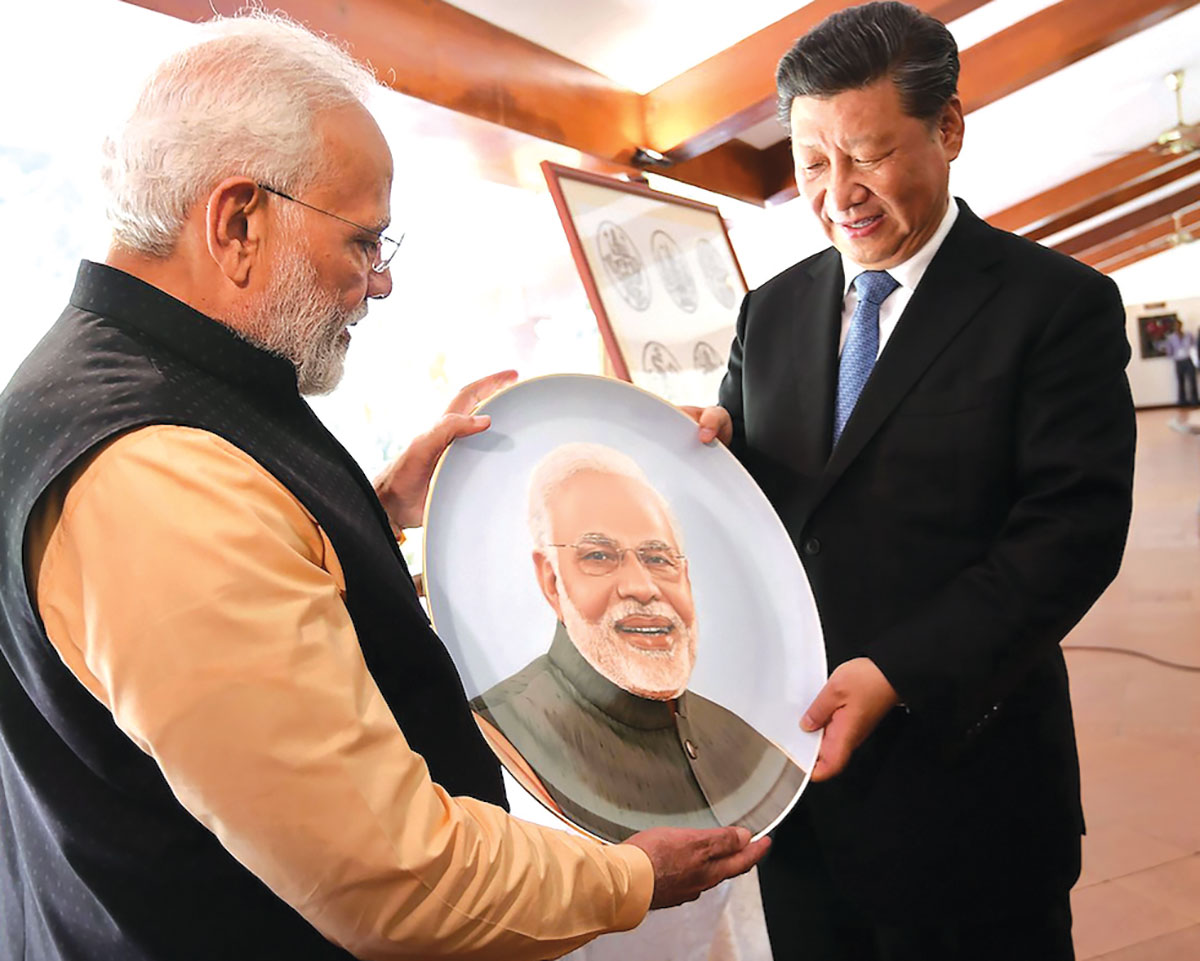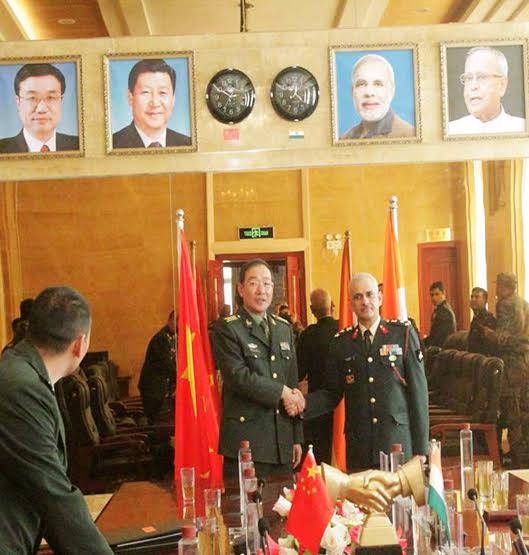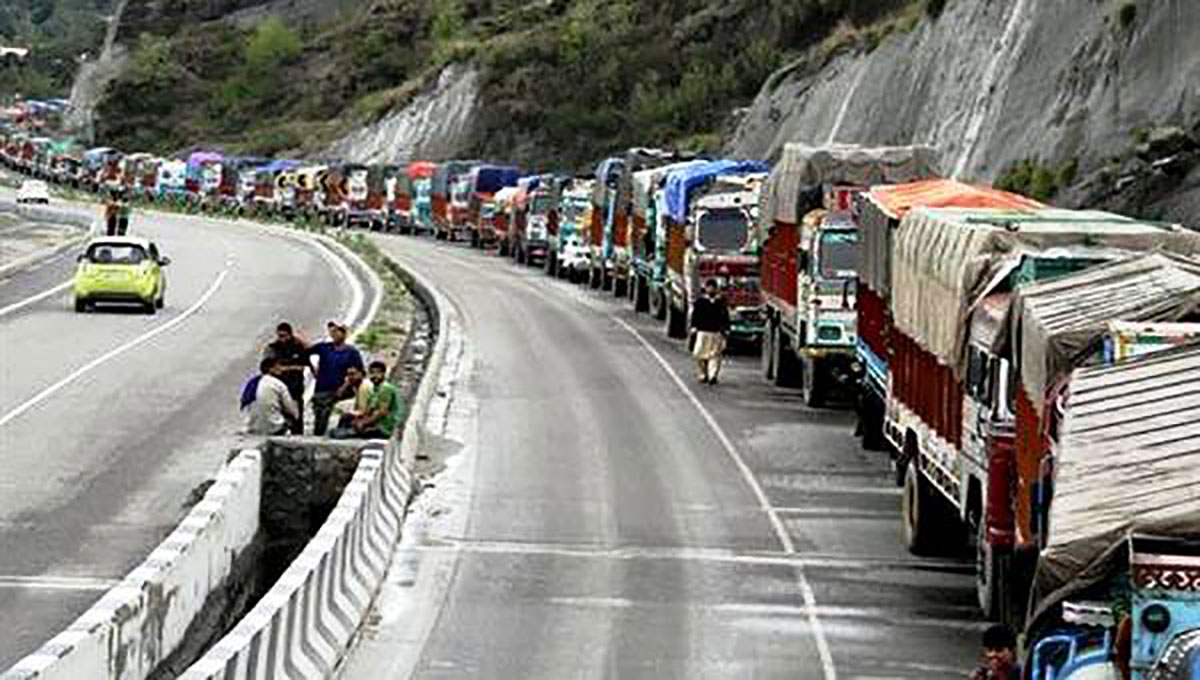After Delhi undid the special status of Jammu and Kashmir and reorganised the state into two federally governed Union Territories in 2019, Beijing had been critical of the development especially on Ladakh. It was after a series of verbal duels on diplomatic front that the summer incursions were reported in Galwan Valley and other spots in Eastern Ladakh, a tension both countries are trying to ease

“Kashmir is an integral part of India, there is no doubt over it,” Home Minister Amit Shah said in his speech in Lok Sabha on August 6, 2019, while moving the resolution for the abrogation of Article 370. “When I talk about Jammu and Kashmir, Pakistan occupied Kashmir and Aksai Chin are included in it.”
Somebody from the opposition benches said the Home Minister was getting “worked up”, according to The Indian Express. Shah hit back, this time pointing towards Congressman Adhir Ranjan Chowdhury: “How can you not consider Pakistan occupied Kashmir as a part of India. We will give our lives for this region. When I say Jammu and Kashmir, I also include PoK. As clearly mentioned in the Constitution, the boundaries of Jammu and Kashmir include PoK and Aksai Chin.”
The same afternoon, Beijing reacted by issuing two statements.
“We urge India to be cautious in its words and deeds on the border issue, strictly abide by the relevant agreements reached between the two sides, and avoid taking actions that further complicate the border issue,” The Hindustan Times reported quoting a statement published on China’s foreign ministry’s website. “China has always opposed India’s inclusion of Chinese territory in India’s administrative jurisdiction in the western part of the Sino-Indian border. This position is firm, consistent and has never changed.”
It added: “In recent days, the Indian side has continued to undermine China’s territorial sovereignty by unilaterally amending its domestic laws. This practice is unacceptable and will not produce any effect.”

The newspaper reported the ministry had issued another statement regarding the situation on borders between India and Pakistan. “China is seriously concerned about the current situation in Kashmir. China’s position on the Kashmir issue is clear and consistent. This issue is a legacy of history between India and Pakistan, which is also the consensus of the international community,” the statement, as quoted by the newspaper, said. “The parties concerned should exercise restraint and act with caution, especially to avoid actions that unilaterally change the status quo and exacerbate the tension. We call on the two sides to peacefully resolve relevant disputes through dialogue and consultation and safeguard regional peace and stability.”
The same night, Raveesh Kumar, spokesman of MEA in Delhi said the abrogation of Article 370and setting up of two UTs was “an internal matter concerning the territory of India”. India, he said, does not comment on the internal affairs of other countries and similarly expects other countries to do likewise.
Jaishanker In Beijing
By later next week, India’s first career diplomat who became the Foreign Minister, S Jaishanker flew to Beijing on a three days visit on August 11. The longest-serving India envoy in Beijing for four years till 2013, Jaishankar had two meetings with his counterpart, Wang Yi. His visit came barely two days after Pakistan Foreign Minister Shah Mehmood Qureshi visited China, seeking support over Kashmir in the UN. It was after his meeting, according to The Hindu that Wang Yi stressed that the Kashmir issue “should be properly and peacefully resolved based on the UN charter, relevant UN Security Council resolutions and bilateral agreement.”

Jammu and Kashmir, in a way, was already in Beijing before Jaishankar made his maiden visit. His visit, as The Economic Times put it, was aimed at soothing “ruffled feathers over Beijing’s concerns.”
“The legislative measures were aimed at better governance and socio-economic development,” Jaishankar was quoted by The Hindu telling his Chinese interlocutors on the undoing of Article 370 and reorganising the state. “There was no implication for the external boundaries of India or the Line of Actual Control with China. India was not raising any additional territorial claims. The Chinese concerns in this regard were misplaced.” On the same analogy, he said India’s decision-making lacks any bearing on the Line of Control with Pakistan. Insisting the decision-making was India’s “internal matter”, the visiting minister asserted: “The issue related to changes in a temporary provision of the Constitution of India and was the sole prerogative of the country.”
He told the Indian media that he raised the issue of Aksai Chin – a territory under Chinese control but claimed by India, in his talks.
Asked by the Indian media if he had objected to China’s reference to the UN Charter and UN Security Council resolutions to resolve the Kashmir issue following Wang- Qureshi talks, Jaishankar said: “I am not here to have an argument with something they (the Chinese) did with Pakistan or some other country. I am here to represent my position and have a conversation with my counterpart. My counterpart raised certain issues related to legislative changes in India. I replied to that.”
Global Times, the main Chinese mouthpiece offered more details of the deliberations between the two foreign ministers. “Wang said China is concerned about the current Kashmir situation and the escalating India-Pakistan conflict. India’s move to end the constitutional status of Jammu Kashmir will change the status quo of the disputed area and result in regional tensions, he added” the newspaper reported on the meeting on August 12, 2019. “Wang also said the Indian government’s announcement of the establishment of the Ladakh Union Territory, which involves Chinese territory, has posed a challenge to China’s sovereignty and violated the two countries’ agreement on maintaining peace and stability in the border region.”
Terming the rollback of Article 370 as “a carnival of nationalism”, the newspaper report added further: “India’s move is neither valid to China nor will change the status quo that China exercises sovereignty and administrative jurisdiction over the territories involved, Wang stressed.”
China Initiated UN Meeting
Notwithstanding these efforts, the United Nations Security Council had a closed-door meeting on Kashmir at the behest of China on August 16, 2019, perhaps for the first time in five decades. As the five permanent members and 10 non-permanent members attended the meeting, neither India nor Pakistan was part of the deliberations.

Though UNSC took no action – no statement was issued, the members, according to website First Post did urge India and Pakistan to refrain from actions that would worsen the tensions in the region, while agreeing to follow the situation closely. They wanted the two countries to avail peaceful means to settle the issues.
“It’s the general view of members that parties concerned should refrain from taking any unilateral action which might further aggravate the tension there since the situation is already very tense and very dangerous,” Chinese ambassador to the UN Zhang Jun was quoted saying. He said the international community’s consensus is that the status of Kashmir is undecided, it is “an internationally-recognised dispute” and should be resolved peacefully in accordance with the UN Charter, UN Security Council resolutions and bilateral agreements.
Chinese and Pakistani diplomats jointly briefed the media and India’s UN ambassador Akbaruddin Ahmad also made a separate presentation to the media.
Despite all this, Chinese President Xi Jinping kept his date with Prime Minister Modi for the second informal summit in Mamallapuram on October 11 where they decided to celebrate 2020 as the 70th anniversary of the establishment of India-China relations by deepening people-to-people and military contacts.
UTs Emerge
On October 31, when the state of Jammu and Kashmir became history with the emergence of Union Territories of Ladakh and Jammu and Kashmir, China reacted again.
“The Indian government officially announced the establishment of so-called Jammu and Kashmir and Ladakh Union Territories which included some of China’s territory into its administrative jurisdiction,” Press Trust of India quoted China’s Foreign Ministry spokesman Geng Shuang telling media in Beijing. “China deplores and firmly opposes that. India unilaterally changed its domestic laws and administrative division challenging China’s sovereignty.”

“This is unlawful and void and this is not effective in any way and will not change the fact that the area is under Chinese actual control,” Geng Shuang further said. “China urges the Indian side to earnestly respect Chinese territorial sovereignty, abide by our treaties and uphold peace and tranquillity in the border areas and create favourable conditions for the proper settlement of boundary question.”
“We do not expect other countries, including China, to comment on the matters which are internal to India, just as India refrains from commenting on internal issues of other countries,” MEA spokesman reacted. He said Beijing was “ill-suited to comment on J&K” because it was in occupation of a large tract of the area in the UTs of Jammu and Kashmir and Ladakh and has “illegally acquired Indian territories from Pakistan-occupied Kashmir (PoK) under the so-called China-Pakistan Boundary Agreement of 1963.”
New Maps
As a Lieutenant Governor took over the administration of the federally governed Union Territories, the MHA in Delhi issued a notification detailing the boundaries of the newly created UTs on November 3, 2019. It showed Gilgit-Baltistan, Gilgit Wazaratbad and Aksai Chin as part of the UT of Ladakh and Pakistan administered Kashmir (PaK) as part of the UT of Jammu and Kashmir.

Apart from being an ally, China has direct stakes. Its multi-billion China-Pakistan Economic Corridor (CPEC) passes through Gilgit-Baltistan region, part of the erstwhile Jammu and Kashmir state that Pakistan governors almost directly.
A day after, a commentary in the China-controlled Global Times appeared, warning that “India’s border move will trigger new dispute”. Referring to the new maps, the editorial said: “Not recognising the legitimacy of the ‘Union Territory of Ladakh’, China may reinforce its defence at borders with India, will firmly safeguard its sovereignty and territories and enhance communication with Pakistan and jointly oppose India’s move that breaks the status quo.”
Wang Doval Meeting
On December 21, National Security Adviser Ajit Doval and Chinese Foreign Minister Wang Yi, met in Delhi. The two special representatives, according to a communiqué by India focused on taking forward the India-China Closer Developmental Partnership as per the guidance provided by Modi and Xi Jinping meeting in October 2019. Both spoke of “the importance of approaching the boundary question from the strategic perspective of India-China relations and agreed that an early settlement of the boundary question serves the fundamental interests of both countries.”
In January 2020, MEA spokesman in Delhi told reporters that the UNSC was of the view that it was not the right forum for such issues (read Kashmir). This, he said, indicate failure of Beijing raking up the issue at Pakistan’s behest. China’s efforts to get Kashmir discussed again in the UNSC meeting had not materialised in December 2019.

This led to a response from his Chinese counterpart, Geng Shuang. “China’s position is consistent and clear. This issue is a dispute left from history and should be properly resolved following the UN charter, UNSC resolutions, and bilateral treaties and in a peaceful way,” PTI quoted Shuang saying on January 18. “As requested by Pakistan, the Security Council reviewed the Kashmir issue on 15 January. The Security Council members are concerned about the current situation and they called the relevant parties to observe the charter and resolve disputes peacefully, through political dialogue and exercise restraint and work on de-escalation.”
Asked why China alone is speaking unlike other UN members, the spokesman said: “Indeed the UNSC reviewed the Kashmir issue on 15 January and there was no statement. But China as a permanent member participated in the review meeting and what I said was in line with the review. But if you think this is not true then you can look at other sources.” Pressed further, he said: “We haven’t changed our position. The issue between India and Pakistan has always been on the UNSC agenda. The UNSC should pay attention to the issue in Kashmir based on the latest developments. And in this region, there are still International Observer Groups and it has always been on UNSC agenda.”
January was almost repeated in April after the Chinese ambassador at UN talked about Kashmir. He had said that “the issue of Kashmir remains high on the UNSC’s agenda and that China is very closely monitoring the current situation in occupied Kashmir,” according to The Tribune. Delhi reacted triggering a counter from Beijing. Delhi had said that in March 2020, when China led the UNSC for the month, it could not accommodate Pakistan’s request for taking up Kashmir. Since the statement was aimed at Sino-Pakistan relationship, Beijing quickly reacted to it.
Incursions Detected
Eastern Ladakh is known to offer surprises when the herdsmen move with their flocks. This year the incursions were slightly bigger. In May, the Chinese army was reported to have got too deep into the Indian side in three areas – the Pangong So, the Hot Springs and the Galwan Valley. During the intervening night of May 4 and 5, reports said that the rival armies fought each other that left many injured. The deep incursions were detected during the patrolling almost in the same fashion as had happened during 1999 in Kargil. Chinese battle helicopters were flying in the area and satellite images suggested certain quick constructions and major weapons having been forwarded. In anticipation of the incursions, the Indian army had detected doubling of the number of Chinese boats in the lake that is mostly under the Beijing control.
The first confirmation came in a commentary in Global Times that suggested China has “made necessary moves in response to India’s recent, illegal construction of defence facilities across the border into Chinese territory in the Galwan Valley region”.

“The Chinese have a huge build-up that includes upcoming military-style bunkers, new upcoming permanent structures, military trucks, road-building equipment and even a warehouse,” The Tribune reported. “Some of the structures, military camps, road-building equipment and trucks are within the territory of India and in areas that are not disputed, like those at the confluence of the Galwan and Shyok rivers in what is defined as the sub-sector north (SSN).”
By the middle of May, Army Chief General M M Naravane was touring the area. In quick follow up, there were commander level talks. Reports indicated that both the sides have withdrawn a bit from the existing positions but the stalemate has not changed. Though the civilian population is almost 70 km ahead of the Galwan, reports suggested that Chinese continue to be in the territory on this side at places which were never disputed.

“They are in our territory but I can’t say (how deep the penetration is),” Konchok Stanzin, executive councillor for the Chushul constituency in the Leh Autonomous Hill Development Council and a BJP leader, told The Telegraph over the phone. “(But what I have learnt) is that they are where they have been from the beginning (of the crisis). We did not hear they have moved back.”
India and China have unsettled borders. There are multiple versions of the claims based on various lines that British and Chinese experts have drawn late nineteenth and early twentieth century. The Aksai Chin, that was part of Jammu and Kashmir state, was taken over and is in possession of China since the 1962 war. The two countries, however, are managing their patrols on the basis of the Line of Actual Control in the region. Chinese, however, are accused of violating the line and pushing their boundary deep into the India side almost every year.
Summer Incursions
Chinese are routinely getting into remote Ladakh and controlling pastures for their herdsmen. It is impacting the Cashmere rearing Changpa’s who are suffering huge losses for denial of access to their pastures since March. The incursions have become embarrassing for the Modi government especially after the opposition is asking uncomfortable questions.
I hope @RahulGandhi and @INCIndia will agree with my reply based on facts and hopefully they won't try to mislead again.@BJP4India @BJP4JnK @sambitswaraj @JPNadda @blsanthosh @rajnathsingh @PTI_News pic.twitter.com/pAJx1ge2H1
— Jamyang Tsering Namgyal (@jtnladakh) June 9, 2020
“Rahul Gandhi: Have Chinese Occupied Indian Territory?” BJP’s Ladakh MP, Jamyang Tsering Namgyal wrote on Twitter and answered. “Yes, Chinese Occupied Indian territory as under: Aksai Chin (37244 sq km) in 1962 during Congress regime, Tia Pangnak and Chabji Valley (250 km length) in Chumur area till 2008 during UPA regime. Zorawart Fort in Demjok was destroyed by PLA in 2008 and setup PLA’s Observing Point in 2012 during UPA regime and also created Chinese/new Demjok/Colony with 13 cemented houses and India lost Doom Cheley (the ancient trade point) between Dungti and Demjok in 2008-2009 during UPA regime.”
But the experts insist that 2020 incursion is major and different. Some attribute it to the completion of the 255 km Darbuk-Shyok-Daulat Baig Oldie (DSDBO) road that gives Indian army better access to DBO, Depsang plains and the Karakoram pass to a point that separates China’s Xinjiang Autonomous Region from Ladakh. The DSDBO provides India with access to the section of the Tibet-Xinjiang highway that passes through Aksai Chin.
UT Is The Issue?
“As long as Ladakh was a part of J&K, China wasn’t a major factor and its stance remained muted,” P Stobdan, Ladakhi diplomat and former ambassador told The India Defence Research Wing. “But post the events of August 5, 2019, the Chinese have been making belligerent noises, almost trying to convey that they have a stake in Ladakh…Now our map shows UT Ladakh with a 106 km land border directly with Afghanistan’s Badakhshan province. This may have hastened Pakistani and Chinese thinking.”
Stobdan said the Aksai Chin is not part of the Himalayas. “Now they are coming into a water-rich area with three rivers–the Shyok, Galwan and Chang-Chenmo. This is a hugely strategic move,” he was quoted saying, insisting they should not be permitted this. “On the map, it looks very complicated but they have a strategy, design and focus on the big picture. Right now, all their connectivity is north of the Karakoram Valley. They are, for instance, building a new airport in Tashkurgan, north of the Siachen glacier.”
Efforts are underway to manage the crisis using military and diplomatic channels. There have been two meetings at different levels between the two armies. Lt General Harinder Singh, Commander of Leh based 14-Corps met Major General Liu Lin, Chinese Commander on June 6 in the Chushul-Moldo region for more than three hours. Chinese spokesman in Beijing has said the two armies have started implementing the “positive consensus” reached by the senior military officials of the two countries on June 6 aimed at “easing” the situation. His counterpart in Delhi also talked in the same language asserting military-to-military conversation has “worked well”.















